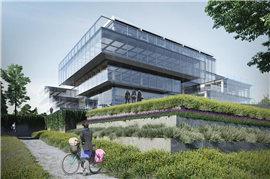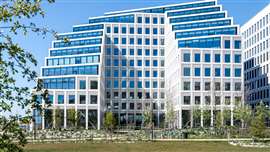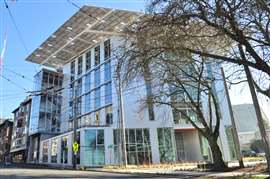Are ‘net-zero’ buildings really net zero?
01 December 2023
It’s a well-known fact that buildings generate a large proportion of the world’s energy-related carbon emissions: 28% in total.
But as world leaders gathered for the 28th United Nations Climate Change Conference (COP 28) in Dubai (30 November-12 December), a new report has laid bare another finding and one that is just as uncomfortable.
Of the many buildings that are being constructed around the world that are touted as “net zero”, very few of them truly are in operation.
That is what has come out of a report from the World Business Council for Sustainable Development (WBCSD) in collaboration with engineering consultancy Arup.
The report’s authors have warned that without major progress, the built environment will be unable to reach the UN 2030 built environment breakthrough goal, which demands that all new and refurbished buildings completed from 2030 should be net zero carbon in operation.
In fact, CO2 emissions from buildings in operation have reached an all-time high of around 10GtCO2, which is 5% higher than 2020, according to the UN Environment Programme.
The report said that while embodied carbon is a relatively new area of focus, operational carbon is different in the sense that, from a technical point of view, stakeholders understand energy efficiency and the technical solutions are available to deliver net-zero buildings in operation.
It warned: “We are missing a clear direction to help drive the change needed in behaviours, from investment CEOs through supply chains (design, construction and operation) to individual occupants.”
It found that despite a rise in companies committing to net zero, there is:
- No globally consistent and robust definition of a net-zero building;
- Not one national policy requiring buildings to be truly net zero now or in the future;
- Substantial variation in net-zero standards set by industry certifications;
- A “negligible number” of truly net zero buildings globally.
The report said that while at its simplest, a net-zero building can be defined as one that is 100% powered by its own on-site renewable energy, the goal is “out of reach for the vast majority of buildings”.
The WBCSD and Arup have called for an internationally agreed definition for net zero buildings, to help stimulate more robust national and local government policies and industry standards.
They also want to see a greater distinction between buildings capable of achieving net zero and those that are verifiably net zero operationally.
To be classified as net zero, they want a building to:
- Have reduced its energy demand sufficiently to be consistent with the transition to 100% renewable energy for the market in which it operates;
- Be capable of operating on 100% renewable energy sources (electricity/thermal);
- Purchase 100% renewable energy through a tariff or power purchase agreement that is “demonstrably additional” to national renewable obligations;
In emerging markets where the above is not feasible, purchase carbon offsets to a recognised international standard would be an alternative means of achieving operational net-zero in the short term while transitioning toward net-zero.
Roland Hunziker, director for built environment, WBCSD said, “The buildings sector is critical to achieve the energy transition, as it consumes more than half of the world’s electricity. Reducing energy consumption and switching to renewable energy are two sides of the same coin to achieve net zero operational buildings at scale in line with available capacity.”
3 buildings that demonstrate best net zero practice
The report also highlighted 10 examples of buildings that demonstrate best practice when it comes to the transition to net zero emissions in operation. They include:
Acciona Campus Building 7
 Digital render of Acciona Campus Building 7, Madrid, Spain (Image: Fenwick Ibarren Architects)
Digital render of Acciona Campus Building 7, Madrid, Spain (Image: Fenwick Ibarren Architects)
Spanish infrastructure giant Acciona has built ‘Building 7’ on its campus in Madrid, Spain, which is in the final stages of certification for the LEED v4.1 standard for design and construction, as well as WELL v2 Platinum certification.
The previous building on the site was demolished and a new one was built using 90% of the construction waste on site. Building 7, occupied earlier this year, has a geothermal installation to service its air conditioning and a photovoltaic installation that produces 104 MWh of renewable energy per year.
The building has practically zero-energy building (nZEB) consumption and according to the report, produces 5.19 kg CO2/m2/year.
Skanksa’s Hyllie Terrass, Malmö, Sweden
 Hyllie Terrace, Malmö, Sweden (Image: Skanska)
Hyllie Terrace, Malmö, Sweden (Image: Skanska)
Skanska designed the Hyllie Terrass building before starting construction in 2020 and tenants started moving in this year.
The building forms part of the Swedish construction firm’s attempt to reach net zero CO2 emissions from its own operation and entire value chain by 2045.
The building itself, which is 12 storeys high, is part of the Sweden Green Building Council’s pilot study into a net-zero CO2 emissions certification for buildings.
The building features recycled concrete, recycled construction steel, and a construction site free of fossil fuels. Skanska also asked suppliers and subcontractors to calculate and report their climate footprint.
Bullitt Center, Seattle, Washington
 Bullitt Center, Seattle, Washington, USA (Image: Joe Mabel via Wikimedia Commons)
Bullitt Center, Seattle, Washington, USA (Image: Joe Mabel via Wikimedia Commons)
The Bullitt Center has attained the Living Building certification from the International Living Future Institute (ILFI). Opened in 2013, it uses all-electric reversible heat pumps to exchange energy between the building and 120m underground to heat the building in the winter and cool it in the summer.
It also has an array of photovoltaic solar panels on the roof that produces 230 MWh of electricity per year. There is an on-site system that converts rainwater to potable water and it also has composting toilets
Click here to read the full report: Net-zero operational carbon buildings, State of the Art.
STAY CONNECTED



Receive the information you need when you need it through our world-leading magazines, newsletters and daily briefings.
CONNECT WITH THE TEAM








